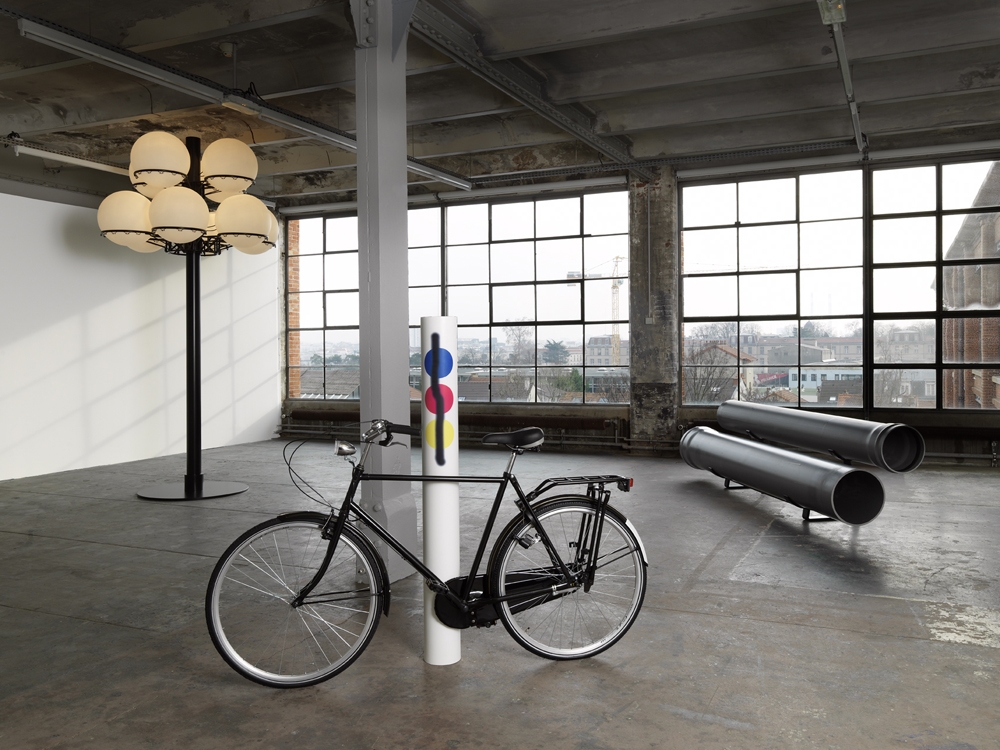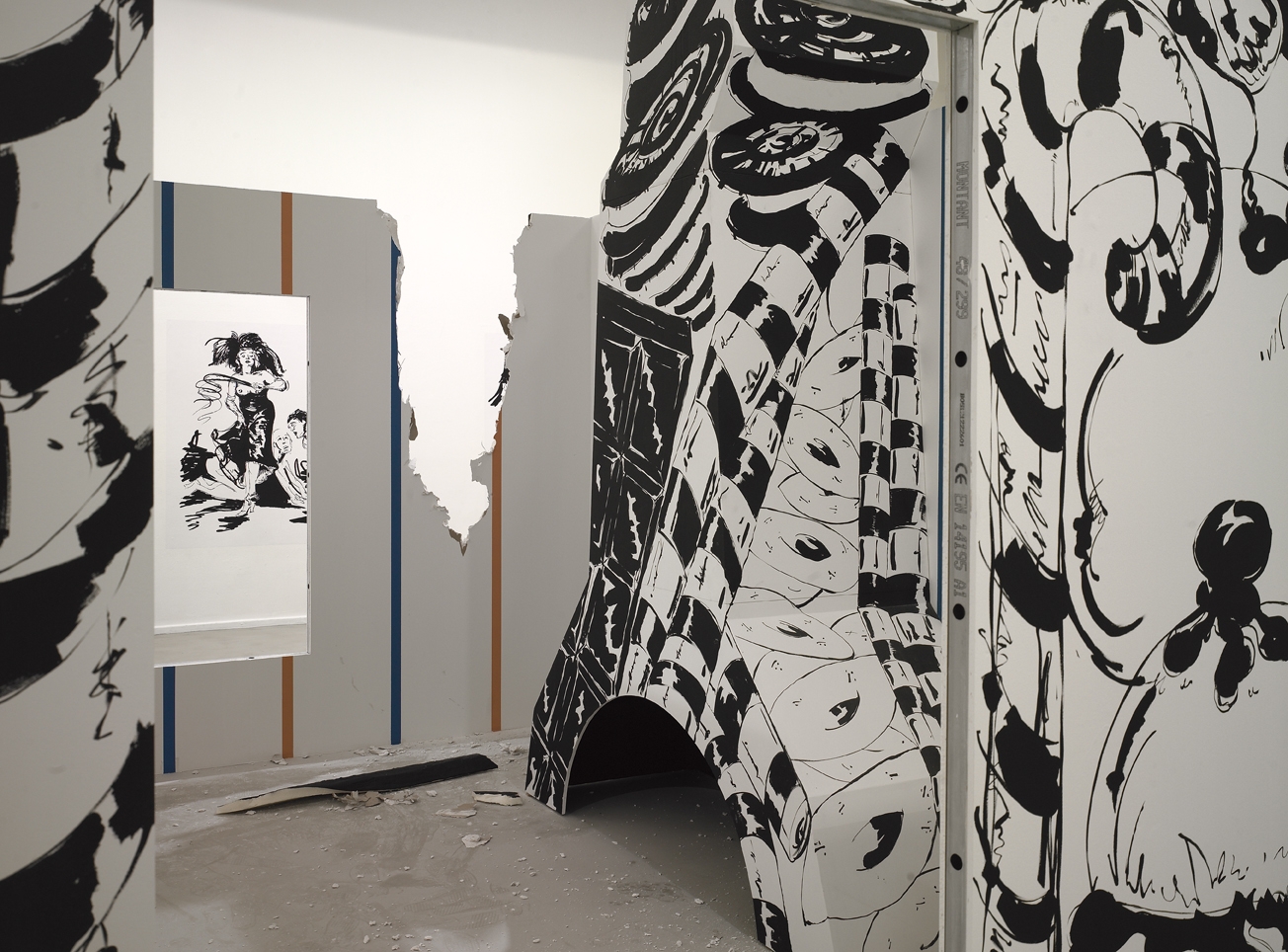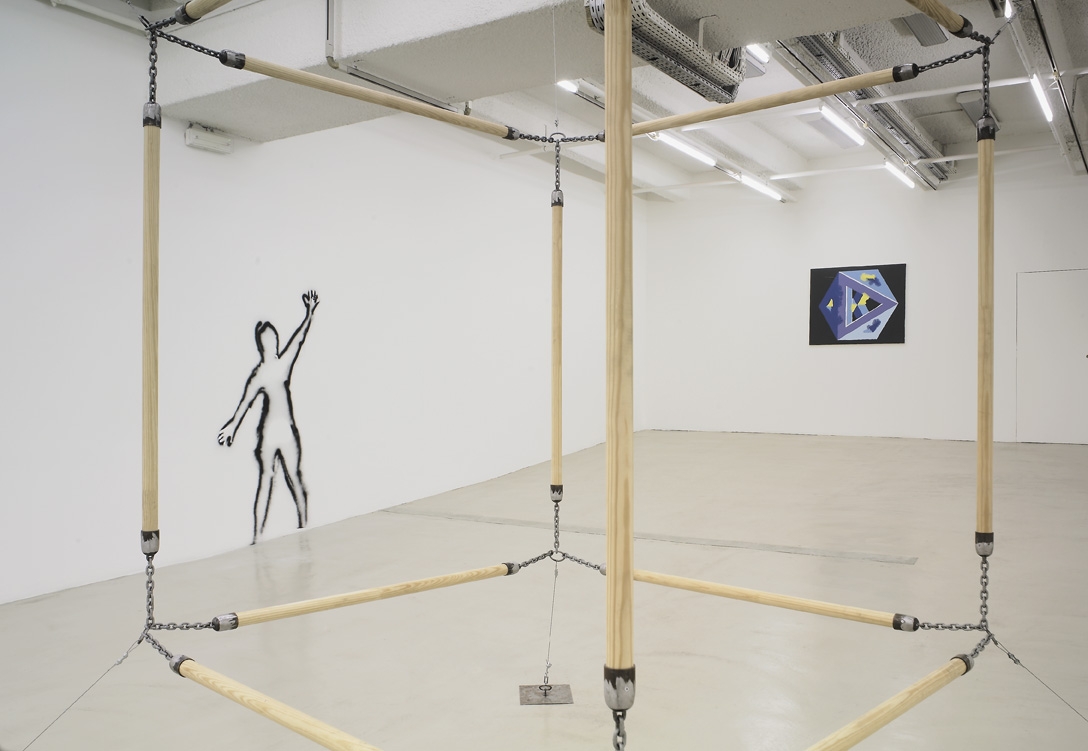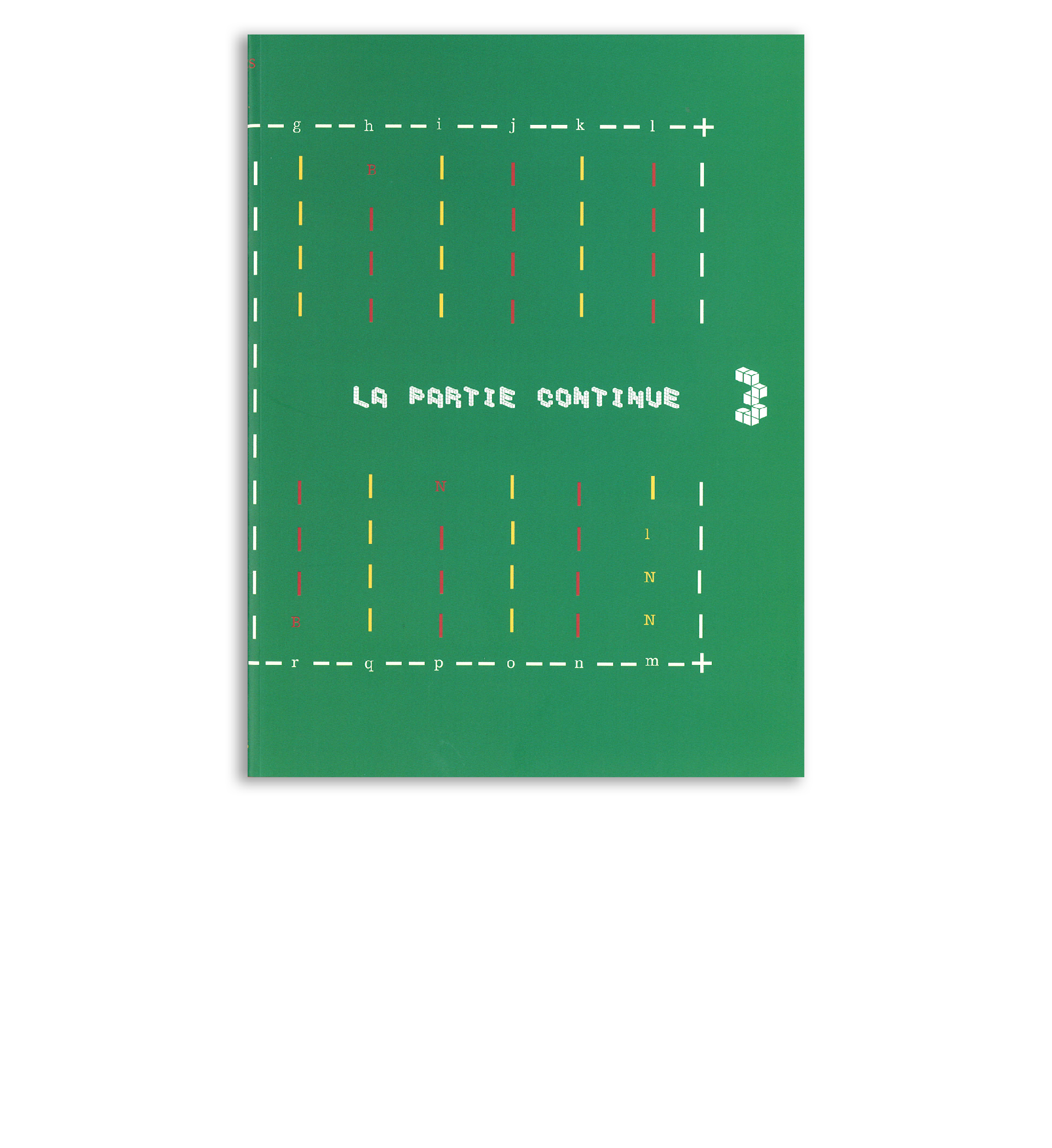La partie continue 1
Group show

Exhibition view La partie continue 1, Centre d’art contemporain d’Ivry – le Crédac, 2004 Karina Bisch - Fachwerk-bauten, 2003, Toile adhésive © Photo : André Morin / le Crédac 2004

Exhibition view La partie continue 1, Centre d’art contemporain d’Ivry – le Crédac, 2004 Nicolas Chardon - Mobile rouge, 2003 - Acrylique sur bois Pièce d’angle, 2003 - Acrylique, tissu monté sur châssis © Photo : André Morin / le Crédac 2004

Exhibition view La partie continue 1, Centre d’art contemporain d’Ivry – le Crédac, 2004 Nicolas Chardon, Mobile rouge, 2003 - Acrylique sur bois Mathieu Mercier, Drum’n bass, 2003 - Etagères, tasse, rouleau de papier, boîte de rangement © Photo : André Morin / le Crédac

Exhibition view La partie continue 1, Centre d’art contemporain d’Ivry – le Crédac, 2004 Karina Bisch, Poison Ivry, 2003 - Bois, Plâtre Didier Marcel, Sans titre, 2002 - Inox poli miroir, motifs sérigraphiés Jacques Julien, Zozio II, 2003 - Résine polyester Olivier Mosset, Sans titre, 1970 - Acrylique sur toile - collection privée © Photo : André Morin / le Crédac

Exhibition view La partie continue 1, Centre d’art contemporain d’Ivry – le Crédac, 2004 Christian Robert-Tissot, Disques d’attente, 2003 - 3 disques en plexiglas, 3 moteurs électriques. Karina Bisch, Poison Ivry, 2003 - Bois, Plâtre / De Brouckere, 2003 - Acrylique sur toile - collection privée. © Photo : André Morin / le Crédac

Exhibition view La partie continue 1, Centre d’art contemporain d’Ivry – le Crédac, 2004 Jacques Julien, Snow ball, 2003 - DVD, vidéo sonore. Stéphane Calais, Brooklyn Style n°2, 2003 - Dessin mural. Barbara Galluci, Begin again2, 1999 - Moquette, banc en bois, DVD - Courtesy galerie Les Filles du Calvaire. François Morellet, Sphère-Trames, 1970 - Sphère métallique tramée, acier inoxydable, tirage : multiple, diam. 60 cm. Fonds National d’Art Contemporain, Ministère de la Culture et de la Communication, Paris. © Photo : André Morin / le Crédac

Exhibition view La partie continue 1, Centre d’art contemporain d’Ivry – le Crédac, 2004 Stéphane Calais, Brooklyn Style n°2, 2003 - Dessin mural / Blindy Blinky2, 2003 - Papier, colle, fil de fer. Barbara Galluci, Begin again2, 1999 - Moquette, banc en bois, DVD - courtesy galerie Les Filles du Calvaire. François Morellet, Sphère-Trames, 1970 - Sphère métallique tramée, acier inoxydable, tirage : multiple, diam. 60 cm. Fonds National d’Art Contemporain, Ministère de la Culture et de la Communication, Paris. © Photo : André Morin / le Crédac

Exhibition view La partie continue 1, Centre d’art contemporain d’Ivry – le Crédac, 2004 François Morellet, Sphère-Trames, 1970 - Sphère métallique tramée, acier inoxydable, tirage : multiple, diam. 60 cm. Fonds National d’Art Contemporain, Ministère de la Culture et de la Communication, Paris. Philippe Decrauzat, Sans titre, 2003 - Acrylique sur toile. © Photo : André Morin / le Crédac








Artists: Karina Bisch, Stéphane Calais, Nicolas Chardon, Philippe Decrauzat, Barbara Gallucci, Jacques Julien, Didier Marcel, Mathieu Mercier, François Morellet, Olivier Mosset, Christian Robert-Tissot
La partie continue / The Game Goes On
“But certainly for the present age, which prefers the sign to the thing signified, the copy to the original, representation to reality, the appearance to the essence… illusion only is sacred, truth profane.” in Ludwig Feuerbach, The Essence of Christianity (1841), quoted by Guy Debord in The Society of the Spectacle (1967).
La partie continue is a project (two exhibitions, a catalogue) inspired at the outset by a place with a singular topography, a sloping ‘white cube’, and a contrasting geometry: the Crédac, set in the foundations of one of the most famous examples of Jean Renaudie’s architecture in Ivry-sur-Seine (1970-1975). This title carries with it the notion of game, somewhere between continuity and discontinuity, losing and winning, check and checkmate. The concepts of quotation, turning around, mixing and borrowing established, it is more the disappearance of the notion of the power, ownership and challenge of heritage that concerns us here. Admittedly, the rules of the game have changed and if the aims have not been the same for many years now, the field has not, for all that, been abandoned.
The idea of making someone else’s work one’s own does not date from the beginning of the eighties. Duchamp’s ready-made (the first pirating) has been widely regarded (in a fairly moralising way) by some critics as an abuse of power, even if it is henceforth an accepted fact.
Fifty years separate La partie continue (2003) from Rauschenberg’s appropriationist gesture (1953) when he created Erased de Kooning drawing by rubbing out a drawing by de Kooning with an eraser. This work has meaning only from the point of view of that which has disappeared. Even if this gesture highlights destructive innuendos, is it, for all that, a crime? Art lives on art! The dominant theme behind the capture of forms belonging to other artists is not evil versus the condition of artistic ownership. The gesture of repetition is by nature iconoclastic, provided the ‘pirate’ makes a sacrifice to Caesar and the source of inspiration is neither secret, nor taboo.
This violent ready-made is a founding act, essential for the capitalisation of forms, ideas and what, much later, artists will call ‘copywrong’. The greatest phenomenon in thinking over these last thirty years is the elimination of identity and, in this case, the uniqueness of the work of art. It makes its (discreet) entrance into the artistic field right from Sturtevant’s first exhibition, at the Bianchini Gallery in New York in 1965. Then, at the beginning of the eighties, it appears in the United States, a specific movement in art, that of “appropriation” or of the ‘appropriationists’. For the artists who are part of this movement, it is a question of, globally, making art with already existing art, or of producing a work by taking up, sometimes very directly, a work produced by another artist, whatever its period of creation. The artists’ position is then to think that ‘repeating’ a work can be a very powerful means of producing a fresh expression. Mike Bildo is similar to a forger. Sturtevant claims to be a copyist and does not wish to be likened to the appropriationist movement. She eliminates the original in favour of re-use and novelty for the already-seen. Philip Taaffe is a pirate. Sherrie Levine is a reproducer. For example, she turns around Roland Barthes’ text on the death of the author: “Similar to those eternal copyists Bouvard and Pecuchet, we indicate the profound ridiculousness that is precisely the truth of painting. We can only imitate a gesture that is always anterior, never original. Succeeding the painter, the plagiarist no longer bears within him passions, humors, feelings, impressions, but rather this immense encyclopedia from which he draws”.
Sherrie Levine will also be compared, for her reasoning, to Pierre Menard, author of Don Quixote in José Luis Borgès’ short story. The simple fact that Pierre Menard decides to rewrite Cervantes’ work and that it appears in a different context brings new meaning to Quixote. Nevertheless, it would seem that the decision of these artists was to show forms of the past again, forms they could not overlook, like a machine that has broken down. Re-use is what’s important. When Sherrie Levine entitles her work After Duchamp (for example), after takes on a double meaning: in the time following and in the style of. The art of the eighties criticised the notions of author or signature without however doing away with them.
La partie continue attempts to show how and why this excellent wealth of forms, this inventory of ideas and thinking, artistic, historical and political positions, still occupies artists today. In an age where the prevailing need is ‘novelty’, we note that this notion is positively foreign to art. Artists themselves put a stop to this obsession with ‘new blood’. They are by turns authors, interpreters, historians, since one of the constituent functions of art is constant redefinition. This ‘game goes on’ like the declaration made by one of Beckett’s characters in The Unnameable: “I can’t go on. I’ll go on”.
This project is neither the reflection of a trend nor a movement (a far too random notion) but rather that of a sign, a fundamental movement. Memory that is kept alive is not ‘against’ but with the end, with distance, with history, with losing. It hardly makes sense to establish classifications that are too rigid anymore; so these artists are not all to be put into the same boat. It is a question of establishing a contact between formally and conceptually hybrid works, using recyling as a new ecology of forms. In this way, the exhibition format takes on the very shape of this concept: hybridism. To create is also to include objects that are already there in new patterns, whether it be the works or the conception of the exhibition itself. Style is no longer bound to an era. The intrusion of formal features from diverse origins and periods enriches the works of these artists, making them more complex. Nevertheless, the desire of each one remains a real or fantasised emancipation, since filiations are double-edged and getting bogged down is a hazard of inertia due to a too weighty heritage.
Daniel Perrier’s work, set in an advertising panel outside the art centre, is more of a mixed quotation that turns its back on academicism. L’après-midi d’un fau(n)v(e) (1954-2004) (two posters back to back ‘corrected’) by Daniel Perrier is conceived from a typographical composition (1954) by Alex Stocker paying tribute to the eponymous poem (1876) by Stéphane Mallarmé and set to music for orchestra (1892-1894) by Claude Debussy. Daniel Perrier uses the word ‘corrected’ in the sense that this project realises the coexistence of the memory of a work (L’après-midi d’un faune) and a typographical game in the form of an illusion. Un faune, une faune, un fauve? Where does the truth of language lie? In a game, a pretext, an illusion… If one takes a closer look, the typography, printed on backlit film, reveals the primary colours on the edges of the letters that would seem a priori to be white on a black background. These primary colours, barely revealed, are the ones Sylvie Fanchon takes care to hide from us in the series Peintures extraites (2003-2004). An attentive eye can make out that her paintings, with weak subjects but strong forms, their origins in motifs that are ‘already there’, in comic strips for example, are not black and white. The whites are unpainted canvas and the blacks are (impure) mixtures of primary colours. Primary colours like Drum’n bass (2003), by Mathieu Mercier whose work here quotes Piet Mondrian’s series of founding paintings, better known to the general public by the “motif” of l’Oréal shampoos.
The exhibition is intended to show how clearly a pool of referents emerges, all linked to a shared interest in the pictorial abstraction of the avant-gardes (Jens Wolf, Nicolas Chardon, Karina Bisch, Mathieu Mercier), while maintaining a complex-free relationship with it. Fanchon’s anti-heroism can also be found (in painting) in Chardon’s work, who (like the magnificent Steven Parrino) is a vandal. He paints well. First. Then, with his hands and feet, he breaks the wooden square that he recycles as Mobile rouge (2003). Furthermore, he stretches Kasimir Malevich’s famous Black Square on a White Field like a metaphor for a “statement” that has softened over the century and that he entitles Pièce d’angle (2003). Philippe Decrauzat, Didier Rittener, Nicolas Chardon, Jens Wolf and John Tremblay’s historically connoted formats are edging towards a formal universe, where borrowing is law, and bringing out the iconology of their ancestry. For Brooklyn style 2, Stéphane Calais disfigures, strikes through with fluorescent spray paint, the black and white drawing he has just made on the wall and that evokes a possible mix of Bridget Riley and Victor Vasarely. Formally there again, softness, flexibility and anti-heroism reign. Like the famous biscuit from Nantes, the perfect sphere of Brooklyn style 1 is suffering from erosion.
Ivan Fayard takes up his place in this kingdom with El pesedos (2004), dripping “tondi” in the form of deformed targets or eyes, painted on the walls of two different levels. Eyes taken from comic strips, so many circles dispersed, an unlikely blend of a work by John Tremblay and Olivier Mosset. John Tremblay, Jens Wolf, Olivier Mosset, Ivan Fayard, Sylvie Fanchon, Karina Bisch, Christian Robert-Tissot call upon knowledge outside of art, but they are themselves situated in the heart of the pictorial process, while disregarding the knowledge of painting itself. All the works shown question the origin of form: whether it be the series of what I call “monuments” (staged ruins): Poison Ivry by Karina Bisch, Zozio II (2003) by Jacques Julien, Sans titre (2003), a blind spot in black granite by Mathieu Mercier, Chair frame (for a garden) (2003) by Martin Boyce, icons of modernist design inspired by creations of garden chairs by Charlotte Perriand, asserting both human presence and absence. These monuments are fossils too. Or forms with more modest dimensions: Danger zone (2003) by Didier Rittener, a series of black polyhedrons in painted wood placed on the floor, aligned in the shape of a diamond, Pendant 1 (2003) by Delphine Coindet, an acid (pop) and transparent (modern) form, a sort of woman’s oversized gem flirting with its soft, felt pedestal and, like an echo of Pendant 1, Sphère trames (1970) by François Morellet, in stainless steel. Simple quotations require that one be content with the ambitions of a critical system, but that is not what concerns these artists. What does concern them is more of a pretext for a work of interpretation of what they regard as being out of copyright: Ivan Fayard, Mathieu Mercier, Sylvie Fanchon, Martin Boyce, Daniel Perrier, Barbara Gallucci.
Hegel wrote somewhere that working on memory was not necessarily synonymous with a return to the past. This is perhaps why some of the artists in the exhibition very often call upon elements with loop effects: Reuse (2000) by Anselm Reyle, a flexible neon light in the form of a spiral wrapped around a worn out fishing net, John Tremblay and his brilliant speedway for the retina Curved air (1998), the anti-Sisyphus video by Jacques Julien, Snow ball (2003) and his shapeless, unstable snowball that will always and forever be hurtling down the black piste of his white mountain. Christian Robert-Tissot sets an abstract motif in motion, multiplied by three, Disques d’attente (2002), taking as a model the busy cursors of our computers, shown back to back with Olivier Mosset’s black circle target Sans titre (1970) that flirts with John Tremblay’s words: “I like to think of Olivier Mosset’s paintings of circles as being Op art. Only their effect would take five years instead of seconds”.
Each game included eleven players. So the match can go on, three authors have enriched the catalogue with their research and commentaries. Nevertheless, La partie continue remains a contemporary project in the sense that something unresolved, latent, possible is still apparent. The exhibition is like Sans titre (2002) by Didier Marcel, two mirrors side by side where, by means of silkscreen printing, fresh perspectives for interpretation appear, a wave and a grid with no edge. Based on reference, these exhibitions were built like mechanisms, that’s to say, made up of heterogeneous elements, functioning like so many points of view and distinctive features, in order to attempt to establish a connection between the individual works within the encompassing context of the whole. The tilt of Decrauzat’s “shaped canvas”, Sans titre (2003), embraces the slanted floor, the trajectories traced by Barbara Gallucci’s installation, Begin again (1999), a simple carpet with a tartan motif, zigzag. Hung just above the floor, Sphère trames (1970) by François Morellet breaks away from the area occupied by Stéphane Calais whose mural tricks the eye. Véronique Joumard enables the exhibition to be switched on and off by offering the viewer a Tableau lumière (1990) equipped with a switch, whereas her wall painting is sensitive to the thermal “environment” of the place and its viewers.
Art interests us because it continues to offer situations and forms that remain unfinished, that can be “played with” therefore. La partie continue outlines perspectives, traces lines of force, looks back, moves forward and because, in art as in figure skating, figures are compulsory… the game must go on.
Claire Le Restif
In catalog La Partie Continue, edited by Centre d’art contemporain d’Ivry – le Crédac.
Translated from French by Gabrielle Lawrence.
Video(s)
Film of the exhibition © Claire Le Restif / le Crédac




